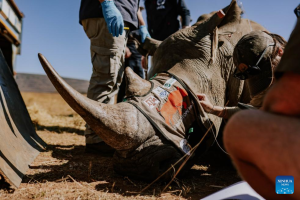South African Scientists Launch Groundbreaking Radioactive Rhino Horn Injection to Combat Poaching
Saint Rich August 5, 2025 0
Spearheaded by the University of the Witwatersrand in collaboration with nuclear energy experts and wildlife conservationists, the project involves injecting rhino horns with trace amounts of radioactive isotopes, a method designed to deter poaching by making horns easily detectable at borders and airports.The project was officially launched on Thursday in Mokopane, Limpopo Province, with five rhinos receiving the radioactive horn injections. These rhinos mark the beginning of what the university hopes will become a wide-scale deployment across South Africa’s increasingly endangered rhino population.

How It Works
The Rhisotope Project utilizes harmless levels of radioactive material injected directly into the horn is like a tissue similar to human fingernails. According to researchers from the Radiation and Health Physics Unit at the University of the Witwatersrand, extensive pilot studies have shown the process to be completely safe for the animals.“The tests we conducted during the initial pilot phase confirmed that the isotopes are non-toxic and pose no health risk to the rhinos,” said Professor James Larkin, chief scientific officer at the Rhisotope Project. “We have demonstrated, beyond scientific doubt, that the process is completely safe for the animal and effective in making the horn detectable through international customs nuclear security systems.”
A New Weapon in the War Against Poaching
The innovative strategy was built on a series of trials conducted last year, during which approximately 20 rhinos at a sanctuary were injected with radioactive isotopes. These initial experiments helped lay the groundwork for Thursday’s official launch.What sets this approach apart is its ability to seamlessly integrate with existing global security infrastructure. Radiation detectors, which are already in place at many airports and border checkpoints worldwide, are capable of identifying even low levels of radioactive materials. By making the horns detectable through such systems, authorities are given a powerful tool to intercept illicit rhino horn trafficking and arrest perpetrators.
Why This Matters
Rhinos continue to face the threat of extinction, with poaching driven by the high demand for their horns in black markets, particularly in parts of Asia where they are erroneously believed to have medicinal properties or are used as luxury items. Despite stringent anti-poaching laws and increased patrolling efforts, criminal networks remain persistent and sophisticated.The Rhisotope Project offers a technological leap forward in the ongoing conservation battle. Unlike dehorning or armed interventions, this method does not diminish the horn’s appearance or function — making it less likely that poachers will be able to identify treated animals in the wild. However, once a horn is removed and trafficked, it becomes a radioactive liability — easily traceable and potentially incriminating.
Looking Ahead
The ultimate goal of the Rhisotope Project is to extend the horn treatment to as many rhinos as possible, transforming them from easy targets into high-risk contraband. By marrying science and conservation, the initiative offers hope not only for the survival of rhinos but also for broader applications in wildlife protection.“This is a game-changer,” Larkin emphasized. “If implemented widely, it could be one of the most significant technological breakthroughs in wildlife crime prevention.”As the Rhisotope Project gains momentum, it stands as a testament to South Africa’s commitment to innovative, science-driven solutions in the fight to save its most iconic species from extinction.







